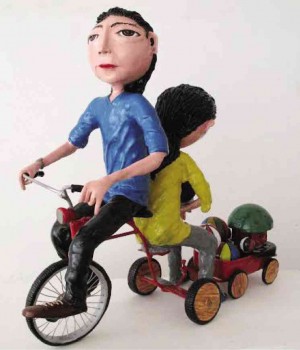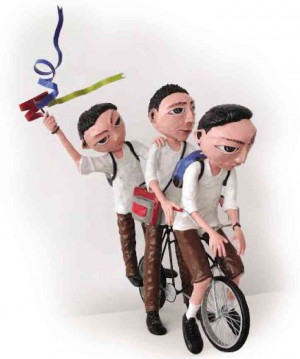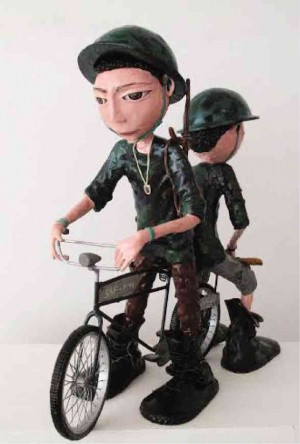‘It was the granddaddy of them all,” remarked National Artist Arturo Luz to this writer’s query as to the origin of his “Cyclist” paintings.
The painting was titled “Bagong Taon.” In his typical, now classic, linear style of painting, he depicted a sight which caught his attention one New Year’s Eve celebration: three men astride a bicycle, merry-making, tooting their paper horns. It was the first time in Philippine contemporary that a bicycle took center stage.
To be sure, another Philippine vehicle has been a popular subject in local art. The jeepney, heralded as “King of the Road,” has held court in numerous canvases, depicted careening down the streets of Metro Manila and other urban cities throughout the land, a vehicular embodiment of Filipino artistry and decorative flamboyance, as evinced in the works of National Artist Cesar Legaspi, Antonio Austria, Emmanuel Garibay, Edwin Wilwayco, to name a few.
Purest expression
An artist from a younger generation, Adrian Jay Manuel takes off from Luz’s “Bagong Taon,” celebrating the bicycle, and its various mutations as a motorcycle, catapulting it off the illusionistic pictorial space of painting into the very real, three-dimensional medium of sculpture.
A solo exhibition organized by Galleria Quattrocento titled “Joy Ride,” puts a fresh spin on the bicycle/motorcycle which literally becomes the purest expression of certain Filipino precious values as well as humorous eccentricities, characteristics which define us as a people.
Within the space of the vehicle, a wide range of behavior, body language, sentiments and emotions is manifested, which Manuel isolates and highlights with a lighthearted affection.
Mistaken
At the outset, it needs to be said that Manuel’s pieces are not made from materials the audience has been accustomed to expect from a piece of sculpture: wood, stone, marble, bronze. They are, in fact, made from epoxy and wads of pulp paper that fill up the bodies that have been molded around a wiry armature.

Moreover, they are bound to be mistaken not as sculptures but… as toys. Interestingly, this parallels the experience of National Artist Arturo Luz: His sculptures of cyclists, acrobats and circus performers were mistakenly construed as playthings. To avert the misconception, he had determined that his sculptures would not involve motion. That, in fact, they are not kinetic sculptures and are, therefore, not to be toyed with.
Manuel, too, had arrived at a similar decision: His bicycles are immobile and the wheels would not roll. It is motion, after all, that sends the wrong signals. (True: The fabled and perfectly balanced mobiles of the American sculptor Alexander Calder are intentionally geared into motion but their gargantuan scale so overwhelms the viewer that they can only marvel in awe from a safe distance.)
Touchingly human
Wide-eyed, with bulbous heads, a cross between a consistently cartoonish mien and a touchingly human gait, strikingly realistic but clearly caught and frozen in mid-gesture, Manuel’s creations are the sculptural equivalent of familiar sights. They are contemporary tipos del pais, an allusion to the subject of 19th century painting. Manuel’s own types consist of, among others, a crisply uniformed girl in “Back to School”; a boy in military uniform with feet shod in oversize shoes in “Son of Mamasapano”; three students astride a bicycle in “Classmates”; peddlers of newspapers in “Delivery Boys”; a balloon vendor reminiscent of our folk genre paintings.
Filipino ingenuity emerges in the uniquely titled “Habal-Habal.” It is a motorcycle, familiar in Cebu and Davao, with an extended rear seating that accommodates as many as five passengers.

In other southern regions like Negros, it is called Skylab, a typical example of Pinoy humor, since the vehicle resembles the wings of the Skylab, which was America’s first manned space station. The fact that it also hurtled and crashed on earth did not deter the locals’ grim sense of humor.
Self-portrait
Starting off as a painter, Manuel had already referenced the vehicle in his works.
One painting may be regarded as a self-portrait: a depiction of a man distressed by an eerie mound of motorcycle spare parts hanging overhead.
The other is a man on a bicycle transfixed by the hypnotic stare and specter of an enormous cat.

Both paintings repose in a surrealistic setting, a chance encounter between human and machine, dream and nightmare, fantasy and reality.
This preoccupation with the bicycle is not surprising, for Manuel is by avocation a collector of bicycles which he purchases but often assembles himself.
As the title of the show suggests, Manuel’s show aims to give the spirit a breezy lift, with mirth and delight, transporting the viewer to a surprise destination of mind and feeling.
In choosing the motorcycle as a metaphoric mode of transport, the sculptor sends the message that Philippine life is a journey traversing the tangled streets of our cities, reminding us that we, by virtue of our vaunted ingenuity and resilience, are all astride a common vehicle, each one crafting and cobbling together the habal-habal of our lives.
Galleria Quattrocento is at the 2/F, Serendra Piazza, McArthur Avenue, Bonifacio Global City, Taguig, Metro Manila. tel no. 8230945










































